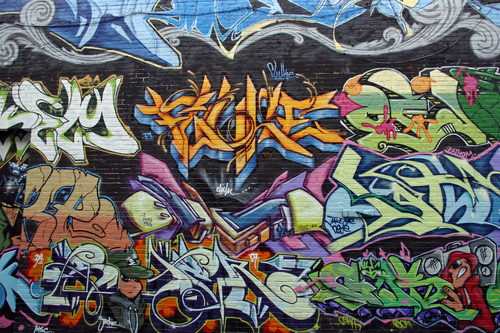
Teaching the History of Graffiti

Graffiti appeals to youth culture, making a unit on graffiti an easy sell to students. Such a unit could be appropriate for a middle school or high school art class. A briefer version—or aspects of it—could fit in a social studies or even an English class. The challenge could be how to present the subject matter objectively. A teacher might embrace this challenge by leaving many of the decisions up to the students.
Although many people revile graffiti, many others accept it as a legitimate art form. Thus, several detailed histories with diverging perspectives exist. A teacher preparing a graffiti unit should seek relatively neutral sources that don’t glorify or decry graffiti or graffiti artists. A good unit should present graffiti as a guerilla art form with vocal supporters and detractors. It should establish graffiti as any unsanctioned writing or images made on public or private property. From there, the unit can detail its multifaceted development.
A thorough history will begin by referencing examples dating back to prehistory through ancient Egyptian and Roman societies. Students can learn about religious and political messages and iconography found across cultures and continents during the Middle Ages. After establishing that graffiti has existed for centuries, leaping forward all the way the 20th Century would be acceptable, as this was the most dynamic period for the medium. The unit should expose students to formative graffiti, such as slogans left by soldiers during World War II and rebellious statements associated with the birth of rock and roll. It can cover the importance of social and political messages scrawled in public spaces during the 1950s and 1960s. The meat of the unit will be what developed in American cities during the 1970s.
Certainly, a teacher can point out how the development of aerosol spray paint made contemporary graffiti possible. A teacher might also add the influence of advertising on graffiti’s emergence. However, nothing will be as relevant as the rise of taggers in American cities. Graffiti as most people think of it starts with the young people who spray painted their “tags” on buildings, bus stops, and subway cars in cities like Philadelphia, New York, and Chicago. The competition to create the most inventive tags and to paint them in the most visible and difficult-to-access places helped spread graffiti. It was blight to many residents and visitors, being associated with the decline of urban living. It developed into a passionate form of expression for the taggers themselves.
The 1970s saw taggers become graffiti artists as particular styles of tagging developed. True, tagging became affiliated with gang culture in some cities. By the early 1980s, it had a greater association with the emergence of hip-hop culture. Many students will associate it with this. To them, the most recognizable graffiti will be from the 1980s onward. Styles became much more elaborate than in previous years. By the end of the decade, the most capable artists had moved on to include highly detailed imagery with their work. Companies aiming products and young people and city dwellers in general began borrowing freely from graffiti culture in their advertising. Eventually, cities began commissioning graffiti artists to create murals using public resources. Students could look for examples of this in their daily lives.
The chronology of the unit could end with today’s prominence of stencil and sticker graffiti, which exists alongside the wildly complex images created in cities around the globe. A teacher might choose to discuss how graffiti is representative of culture spreading globally at the pace of technological development. Students might examine specific styles, works, or artists and trace influences, compare technical merit, or analyze any apparent symbolism. Many students would enjoy creating their own works (on paper, of course). They could be assigned to emulate particular styles based on eras or artists, or they could be given the chance to develop something totally their own. The most engaging part of the unit might involve criticism, not creation.
Teaching the history of graffiti has definite worth. In an art class that combines art history and studio creation, the unit has the potential to be highly engaging. The examination of graffiti can go beyond the art, though. Teachers across several content areas can get students to discuss whether graffiti is vandalism or art, or if it is some combination of the two. Students can be challenged to create arguments that defend or disparage graffiti. Knowing how the medium developed can inform these arguments. The potential to foster critical thinking might be the most important aspect of a graffiti unit. As the arguments develop, the teacher will turn the content over to the students who will use it as fuel for thought. Some would suggest much of the aim of contemporary graffiti is to do just that for the public at large. In the hands of a thoughtful teacher, a unit on the history of graffiti can mimic actual graffiti by being a catalyst for debate.
Written by Jeff Hartman



